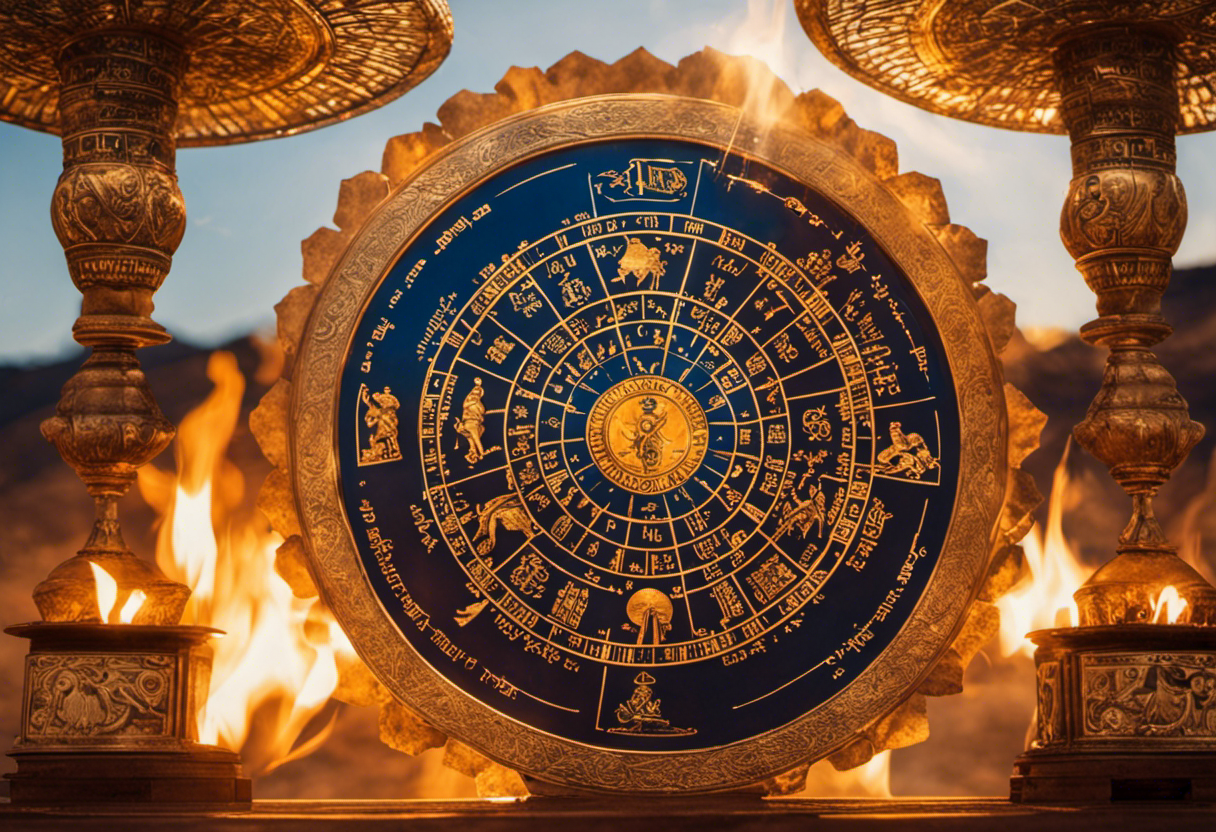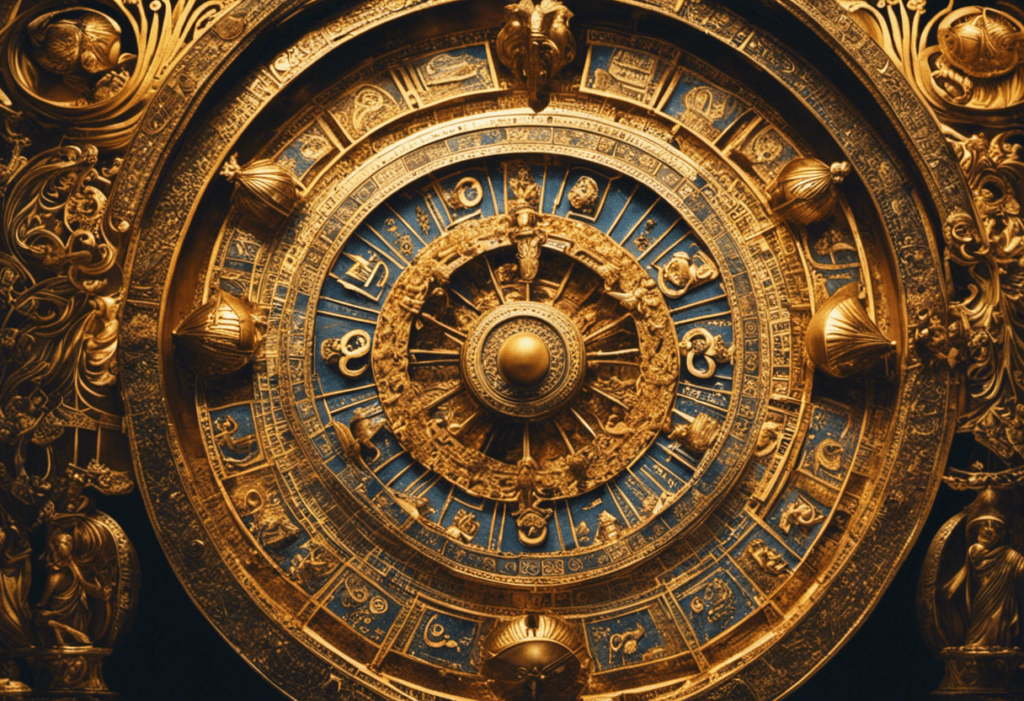In this thought-provoking article, we delve into the profound wisdom concealed within the Zoroastrian calendar.
By analyzing the symbolism, interpreting the festivals, and understanding the philosophical principles, we uncover invaluable insights that transcend time and mortality.
Through the lens of Zoroastrianism, we explore the connection between ancient wisdom and modern life, inviting a deeper understanding of ourselves and the world around us.
Join us on this intellectual journey as we unravel the philosophical treasures derived from the Zoroastrian calendar.
Key Takeaways
- The Zoroastrian calendar contains intricate symbolism that reflects the beliefs of the religion and offers insights into the cosmic order and humanity’s role within it.
- Symbolism in religious practices, such as offering prayers and incense to the fire, conveys deeper meanings and connections within the faith.
- Zoroastrian festivals serve as occasions for spiritual reflection, worship, and fostering a sense of community and togetherness.
- The core principles of Zoroastrianism revolve around the eternal battle between good and evil and the importance of choosing the path of righteousness.
The Symbolism of the Zoroastrian Calendar


The intricate symbolism embedded within the Zoroastrian calendar provides a rich and profound understanding of the celestial cycles and the interconnectedness of life. Ancient calendars often served a dual purpose, as they not only marked the passage of time but also conveyed deeper philosophical meanings through their symbols and rituals.
In the case of the Zoroastrian calendar, this symbolism reflects the fundamental beliefs of the religion and offers insights into the cosmic order and the role of humanity within it.
One key aspect of the Zoroastrian calendar is its division into six seasons, each representing a different stage of the annual agricultural cycle. This reflects the deep connection between nature and human life, emphasizing the importance of harmony and balance with the natural world. The rituals associated with each season, such as the celebration of the spring equinox, further reinforce this connection, reminding individuals of their role as stewards of the earth.
Moreover, the Zoroastrian calendar also incorporates astrological symbolism, with the movements of celestial bodies serving as indicators of spiritual significance. The alignment of the stars and planets within the calendar system highlights the interconnectedness of the physical and spiritual realms, suggesting that one’s actions and choices are influenced by cosmic forces.
Overall, the symbolism in the Zoroastrian calendar offers a profound understanding of the philosophical beliefs and values of the religion. It reminds believers of the importance of living in harmony with nature and recognizing the interconnectedness of all life. Through its rituals and symbols, the calendar provides a framework for individuals to contemplate their place in the universe and strive for spiritual enlightenment.
Interpreting the Festivals of the Zoroastrian Calendar


Interpreting the festivals of the Zoroastrian calendar offers a unique opportunity to explore the symbolism deeply ingrained in this ancient religion. By examining the rituals and practices associated with these festivals, we can gain insights into the core beliefs and values of Zoroastrianism.
Additionally, understanding the cultural significance of these festivals allows us to appreciate the rich tapestry of traditions and customs that have shaped the Zoroastrian community throughout history.
Symbolism in Zoroastrian Festivals
Exploring the rich symbolism embedded within Zoroastrian festivals offers profound insights into the cultural and religious significance of these ancient celebrations. Symbolism plays a crucial role in the interpretation of these festivals, allowing individuals to connect with deeper meanings and understand the underlying teachings and beliefs of Zoroastrianism.
-
Fire: Fire is a prominent symbol in Zoroastrian festivals, representing purity, light, and the divine presence. It is believed to be a medium through which prayers and offerings reach the spiritual realm.
-
Nature: The use of natural elements such as flowers, fruits, and water in Zoroastrian festivals symbolizes the interconnectedness between humans and the environment. It reflects the reverence for nature and the importance of preserving its beauty and resources.
-
Rituals: The various rituals performed during these festivals symbolize purification, renewal, and the triumph of good over evil. They serve as a reminder of the ethical and moral principles upheld by Zoroastrianism.
Cultural Significance of Festivals
Festivals of the Zoroastrian calendar provide valuable insights into the cultural significance and practices of this ancient religion.
These festivals are deeply rooted in cultural traditions and religious customs, offering a glimpse into the beliefs and values of Zoroastrians.
One such festival is Noruz, which marks the beginning of the new year and celebrates the arrival of spring. This festival is characterized by various rituals and customs, including the setting of a Haft-Seen table, which symbolizes rebirth and renewal.
Another important festival is Mehregan, which honors the deity Mithra and celebrates love, friendship, and abundance.
These festivals not only serve as occasions for spiritual reflection and worship, but also foster a sense of community and togetherness among Zoroastrians.
Understanding the Philosophical Principles of Zoroastrianism


Understanding the philosophical principles of Zoroastrianism is crucial in comprehending the essence of this ancient religion. The core principles revolve around the eternal battle between good and evil, emphasizing the importance of choosing the path of righteousness.
Symbolism plays a significant role in Zoroastrian religious practices, offering deeper insights into their beliefs and values.
The philosophical principles of Zoroastrianism have also had a profound influence on modern philosophy, particularly in the fields of ethics and moral decision-making.
Core Zoroastrian Principles
Zoroastrianism emphasizes the importance of the interconnectedness between good thoughts, good words, and good deeds as the core principles guiding one’s moral conduct. These core Zoroastrian beliefs are rooted in the teachings of the prophet Zarathustra, who preached the concept of duality between good and evil.
The ethical teachings of Zoroastrianism revolve around the idea that individuals have the power to choose between these two forces, and their choices will determine their spiritual destiny.
-
Good thoughts: Zoroastrians believe that positive thoughts have the power to shape their actions and the world around them. By cultivating virtuous thoughts, individuals can contribute to the well-being of themselves and others.
-
Good words: Words hold immense power in Zoroastrian ethical teachings. Speaking truthfully, kindly, and with compassion is seen as a way to promote harmony and foster positive relationships.
-
Good deeds: Actions are seen as the physical manifestation of one’s thoughts and words. Performing acts of kindness, charity, and justice is considered essential in living a morally upright life.
Symbolism in Religious Practices
The symbolism in religious practices provides rich insights into the philosophical principles of Zoroastrianism, as it highlights the deeper meanings and connections within the faith. Zoroastrian rituals are filled with symbolic gestures, objects, and actions that serve to convey important messages and teachings.
For example, fire, one of the central symbols in Zoroastrianism, represents purity, light, and the divine presence. The act of offering prayers and incense to the fire symbolizes the devotee’s desire to connect with the divine and to purify their own soul.
Similarly, the ritual of tying the sacred thread, known as the Kusti, around the waist three times symbolizes the commitment to follow the teachings of Zarathustra and strive for spiritual growth.
These symbolic rituals not only deepen the spiritual experience of the individuals but also reinforce the core principles of Zoroastrianism, such as purity, righteousness, and the search for truth.
Influence on Modern Philosophy
Zoroastrianism, an ancient religion originating in Persia, has had a profound impact on ethical and existentialist philosophies. The following points illustrate the influence of Zoroastrianism on modern philosophical thought:
-
Dualism: Zoroastrianism introduced the concept of a cosmic battle between good and evil, which influenced the development of dualistic thinking in philosophy.
-
Moral Responsibility: Zoroastrianism emphasized the importance of individual moral responsibility and the consequences of one’s actions, which shaped ethical theories and discussions on accountability.
-
Free Will: The belief in free will within Zoroastrianism contributed to discussions on human agency and the existence of choice in existentialist philosophies.
Overall, Zoroastrianism’s influence on ethics and its impact on existentialism have contributed to the development of key philosophical concepts and continue to shape modern philosophical thought.
Exploring the Wisdom of the Zoroastrian Months


The current discussion topic involves delving into the profound teachings and practical implications encapsulated within the Zoroastrian calendar’s months. The Zoroastrian calendar, also known as the Iranian calendar, is an ancient system that offers wisdom and insights into various aspects of life. Each month in the calendar represents a unique theme and provides an opportunity for wisdom exploration and philosophical insights.
For instance, the first month, Farvardin, symbolizes new beginnings and renewal. It encourages individuals to reflect on their past actions and strive for personal growth and improvement. The second month, Ordibehesht, focuses on love, beauty, and harmony, reminding us of the importance of fostering positive relationships and appreciating the world’s wonders.
The Zoroastrian calendar’s months offer a structured approach to self-reflection and self-improvement, providing individuals with guidance and inspiration. By exploring the wisdom encapsulated within each month, one can gain valuable insights into various aspects of life, such as morality, spirituality, and interpersonal relationships.
Overall, the Zoroastrian calendar’s months serve as a repository of ancient wisdom, offering individuals a practical framework to cultivate personal growth and explore philosophical insights. By studying and applying the teachings of each month, individuals can enhance their understanding of themselves and the world around them, leading to a more balanced and fulfilling life.
Time and Mortality in the Zoroastrian Calendar


Examining the concept of time and mortality in the Zoroastrian calendar reveals profound insights into the impermanence of existence and the importance of making the most of our fleeting moments.
The Zoroastrian calendar, known as the Fasli calendar, is based on the solar year and consists of twelve months, each with thirty days. This calendar reflects the profound understanding of time and mortality in Zoroastrian philosophy.
-
Impermanence of existence: The Zoroastrian calendar serves as a reminder that time is constantly moving forward, and every moment is fleeting. It emphasizes the transient nature of life and encourages individuals to appreciate the present moment.
-
Importance of reflection: The Zoroastrian calendar provides opportunities for reflection and introspection. It encourages individuals to contemplate their actions, values, and purpose in life. This reflection on mortality can serve as a catalyst for personal growth and self-improvement.
-
Making the most of our fleeting moments: The Zoroastrian calendar highlights the importance of utilizing our limited time wisely. It reminds us that life is short and encourages individuals to seize every opportunity for personal and spiritual development.
The Zoroastrian calendar offers a valuable perspective on time and mortality, emphasizing the impermanence of existence and the significance of making the most of our fleeting moments. It provides philosophical insights that can guide individuals towards leading more purposeful and fulfilling lives.
Applying Zoroastrian Philosophy to Modern Life


Applying Zoroastrian philosophy to modern life requires a deep understanding of its principles and their practical implications. Zoroastrian ethics, rooted in the teachings of the ancient Persian prophet Zoroaster, offer valuable insights into how individuals can lead a virtuous and meaningful life. The core principles of Zoroastrianism, such as the belief in the duality of good and evil, the importance of free will, and the pursuit of truth and righteousness, can be applied to various aspects of daily life.
One key aspect of Zoroastrian philosophy is the emphasis on ethical behavior. Zoroastrians are encouraged to practice honesty, kindness, and compassion in their interactions with others. By applying these values to our own lives, we can foster harmonious relationships and contribute to a more just and compassionate society.
Furthermore, Zoroastrian philosophy teaches the importance of personal responsibility and the power of choice. It emphasizes that individuals have the ability to make conscious decisions that can impact their own lives and the world around them. By recognizing the consequences of our actions and making choices that align with the principles of truth and righteousness, we can lead a more purposeful and fulfilling life.
Conclusion
In conclusion, the Zoroastrian calendar offers profound philosophical insights through its symbolism, festivals, and principles.
The wisdom embedded in its months encourages us to reflect on our actions and strive for moral righteousness.
This ancient calendar also reminds us of the passage of time and the inevitability of mortality.
By applying Zoroastrian philosophy to modern life, we can gain a deeper understanding of ethical living and cultivate a more meaningful existence.
The Zoroastrian calendar serves as a timeless allegory, guiding us towards a virtuous path.



